
Illustrative Math Alignment: Grade 6 Unit 9
Putting it All Together
Lesson 3: Rectangle Madness
Use the following Media4Math resources with this Illustrative Math lesson.
| Thumbnail Image | Title | Body | Curriculum Topics |
|---|---|---|---|
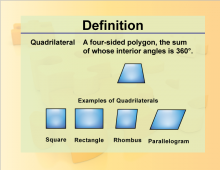
|
Definition--Geometry Basics--Quadrilateral | QuadrilateralTopicGeometry Basics DefinitionA quadrilateral is a polygon with four sides and four angles. DescriptionQuadrilaterals are an essential topic in geometry that encompasses various shapes like squares, rectangles, trapezoids, and parallelograms. The sum of interior angles in any quadrilateral is 360 degrees. Understanding various types of quadrilaterals is crucial for solving problems related to area, perimeter, and angles within these shapes. Quadrilaterals find applications in fields such as architecture and engineering due to their structural significance. |
Definition of a Quadrilateral |
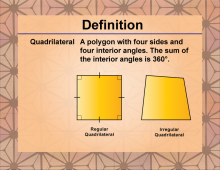
|
Definition--Polygon Concepts--Quadrilateral | Definition--Polygon Concepts--QuadrilateralTopicPolygons DefinitionA quadrilateral is a polygon with four sides, four vertices, and four angles. The sum of the interior angles of a quadrilateral is always 360 degrees. DescriptionQuadrilaterals are fundamental shapes in geometry, characterized by their four sides and four vertices. They serve as a bridge between simpler shapes like triangles and more complex polygons, making them essential for understanding geometric principles and properties. The study of quadrilaterals involves exploring various types such as squares, rectangles, trapezoids, and parallelograms, each with unique properties and applications. |
Definition of a Polygon |

|
Definition--Quadrilateral Concepts--Inscribed Square | Definition--Quadrilateral Concepts--Inscribed SquareTopicQuadrilaterals DefinitionAn inscribed square is a square drawn within a circle such that all four vertices of the square touch the circle. |
Definition of a Quadrilateral |
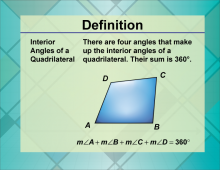
|
Definition--Quadrilateral Concepts--Interior Angles of a Quadrilateral | Interior Angles of a QuadrilateralTopicQuadrilaterals DefinitionThe sum of the interior angles of a quadrilateral is always 360 degrees. |
Definition of a Quadrilateral |

|
Definition--Quadrilateral Concepts--Diagonals of a Quadrilateral | Diagonals of a QuadrilateralTopicQuadrilaterals DefinitionThe diagonals of a quadrilateral are the line segments that connect opposite corners. DescriptionThe diagonals of a quadrilateral provide insights into the shape's symmetry and balance, which are important in both theoretical and practical applications. This concept is used in fields such as computer graphics and design, where understanding the internal structure of shapes is crucial. Understanding diagonals is a fundamental part of math education, as it helps students develop spatial reasoning skills. |
Definition of a Quadrilateral |
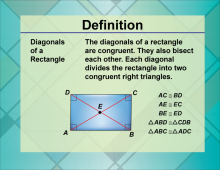
|
Definition--Quadrilateral Concepts--Diagonals of a Rectangle | Diagonals of a RectangleTopicQuadrilaterals DefinitionThe diagonals of a rectangle are equal in length and bisect each other. DescriptionThe property of diagonals being equal and bisecting each other in a rectangle is a fundamental concept in geometry. This property is applied in various fields, such as architecture and engineering, where precision in measurements is crucial. Understanding this concept is important in math education as it helps students grasp the relationships between different parts of a shape and develop spatial reasoning skills. |
Definition of a Quadrilateral |
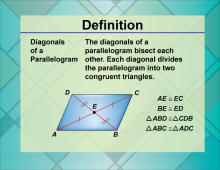
|
Definition--Quadrilateral Concepts--Diagonals of a Parallelogram | Diagonals of a ParallelogramTopicQuadrilaterals DefinitionThe diagonals of a parallelogram bisect each other. DescriptionThe property of diagonals bisecting each other in a parallelogram is a key concept in geometry, illustrating the symmetry and balance within these shapes. This property is applied in various fields, such as engineering and architecture, where understanding the internal structure of shapes is crucial. Mastery of this concept is important in math education as it helps students understand the relationships between different parts of a shape. |
Definition of a Quadrilateral |

|
Definition--Quadrilateral Concepts--Diagonals of a Trapezoid | Diagonals of a TrapezoidTopicQuadrilaterals DefinitionThe diagonals of a trapezoid are line segments connecting the opposite corners. |
Definition of a Quadrilateral |
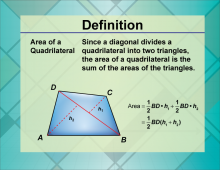
|
Definition--Quadrilateral Concepts--Area of a Quadrilateral | Area of a QuadrilateralTopicQuadrilaterals DefinitionThe area of a quadrilateral can be determined using various formulas depending on its type. |
Definition of a Quadrilateral |
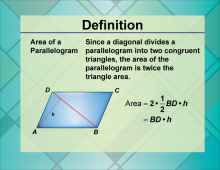
|
Definition--Quadrilateral Concepts--Area of a Parallelogram | Area of a ParallelogramTopicQuadrilaterals DefinitionThe area of a parallelogram is calculated by multiplying the base by the height. |
Definition of a Quadrilateral |
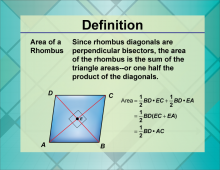
|
Definition--Quadrilateral Concepts--Area of a Rhombus | Area of a RhombusTopicQuadrilaterals DefinitionThe area of a rhombus can be found using the formula A = (d1 × d2)/2. DescriptionThe area of a rhombus, an intriguing type of quadrilateral, is essential in design and architecture. Utilizing the formula A = (d1 × d2)/2 where d1 and d2 are the lengths of the diagonals, one can solve complex spatial problems. This concept illustrates the interplay between geometry and design, making it extremely relevant in math education. |
Definition of a Quadrilateral |

|
Definition--Quadrilateral Concepts--Area of a Rectangle | Area of a RectangleTopicQuadrilaterals DefinitionThe area of a rectangle is computed as length times width. DescriptionThe area of a rectangle is a foundational concept in geometry, widely utilized in various real-world applications including furniture design and urban planning. The area is given by the formula A = length × width. Grasping this concept provides a basic understanding of spatial relationships essential in mathematics, which is vital for students to progress in their math education. |
Definition of a Quadrilateral |
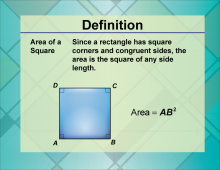
|
Definition--Quadrilateral Concepts--Area of a Square | Area of a SquareTopicQuadrilaterals DefinitionThe area of a square is calculated as side length squared. DescriptionThe area of a square is fundamental in various fields such as mathematics and engineering. The formula is A = side2 demonstrating the square's properties and its applications in real-world contexts like floor planning and landscaping. Mastery of this concept is crucial for students to develop a comprehensive understanding of geometry within their math education. |
Definition of a Quadrilateral |
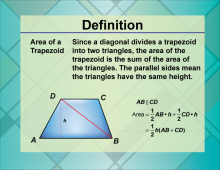
|
Definition--Quadrilateral Concepts--Area of a Trapezoid | Area of a TrapezoidTopicQuadrilaterals DefinitionThe area of a trapezoid is calculated using the formula DescriptionThe area of a trapezoid is a significant concept in geometry, with applications in fields such as architecture and engineering. The formula for calculating the area is |
Definition of a Quadrilateral |

|
Definition--Quadrilateral Concepts--Perimeter of a Quadrilateral | Perimeter of a QuadrilateralTopicQuadrilaterals DefinitionThe perimeter of a quadrilateral is the sum of the lengths of all its sides. DescriptionCalculating the perimeter of a quadrilateral is a basic yet crucial learning objective in geometry. It finds application in everyday scenarios, such as fencing a yard or styling an outdoor space. This fundamental concept is pivotal for developing measurement skills within mathematics. Understanding how to determine the perimeter equips students with essential tools to solve more complex problems in their mathematical journey. |
Definition of a Quadrilateral |
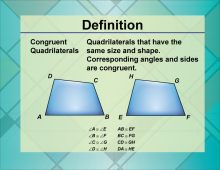
|
Definition--Quadrilateral Concepts--Congruent Quadrilaterals | Congruent QuadrilateralsTopicQuadrilaterals DefinitionCongruent quadrilaterals are quadrilaterals that have the same size and shape. DescriptionThe concept of congruent quadrilaterals is essential in geometry, as it helps in understanding the properties of shapes that are identical in form. This concept is used in various real-world applications, such as in design and construction, where it is important to ensure that components are congruent for structural integrity. Understanding congruence is crucial in math education as it lays the foundation for more advanced geometric concepts. |
Definition of a Quadrilateral |
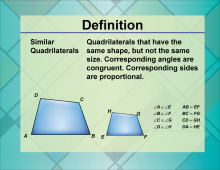
|
Definition--Quadrilateral Concepts--Similar Quadrilaterals | Similar QuadrilateralsTopicQuadrilaterals DefinitionSimilar quadrilaterals are quadrilaterals that have the same shape but different sizes. DescriptionUnderstanding similar quadrilaterals profoundly impacts students' comprehension of proportional reasoning and geometric transformations. This concept finds applications in scaling models in architecture and art. Recognizing the properties of similarity aids students as they develop critical skills that are fundamental for success in later math courses, particularly in geometry and trigonometry. |
Definition of a Quadrilateral |
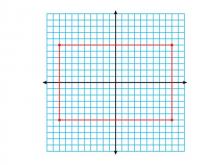
|
Math Clip Art--Geometry Concepts--Quadrilaterals--Rectangle Centered at the Origin | Math Clip Art--Quadrilaterals--Rectangle Centered at the OriginTopicGeometry Concepts DescriptionThis image shows a rectangle centered at the origin of a coordinate grid. This positioning allows for easy analysis of its properties, such as symmetry and dimensions, using the Cartesian coordinate system. Understanding how to position geometric shapes at the origin is crucial for exploring concepts like symmetry, transformations, and coordinate geometry. This setup simplifies calculations involving distance, midpoint, and area. |
Definition of a Quadrilateral |

|
Math Clip Art--Geometry Concepts--Quadrilaterals--Rectangle in Q1 | Math Clip Art--Quadrilaterals--Rectangle in Q1TopicGeometry Concepts DescriptionThis image depicts a rectangle positioned in the first quadrant (Q1) of a coordinate grid. In Q1, both the x and y coordinates are positive, making it a straightforward area for graphing and analysis. Placing a rectangle in Q1 helps students understand the relationship between geometric shapes and their coordinate representations. It is useful for exploring concepts like area, perimeter, and transformations. |
Definition of a Quadrilateral |
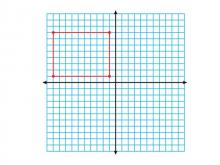
|
Math Clip Art--Geometry Concepts--Quadrilaterals--Rectangle in Q2 | Math Clip Art--Quadrilaterals--Rectangle in Q2TopicGeometry Concepts DescriptionThis image shows a rectangle positioned in the second quadrant (Q2) of a coordinate grid. In Q2, the x-coordinates are negative while the y-coordinates are positive, which is important for understanding the full Cartesian plane. Understanding how to place rectangles in different quadrants helps students grasp the concept of negative and positive values in coordinate geometry. It is crucial for graphing functions, analyzing data, and understanding geometric transformations. |
Definition of a Quadrilateral |
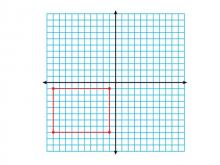
|
Math Clip Art--Geometry Concepts--Quadrilaterals--Rectangle in Q3 | Math Clip Art--Quadrilaterals--Rectangle in Q3TopicGeometry Concepts DescriptionThis image illustrates a rectangle positioned in the third quadrant (Q3) of a coordinate grid. In Q3, both x and y coordinates are negative, which is essential for understanding the complete Cartesian coordinate system. Placing rectangles in different quadrants helps students understand the concept of negative values and their implications in geometry. It is crucial for graphing functions, analyzing data, and exploring geometric transformations. |
Definition of a Quadrilateral |
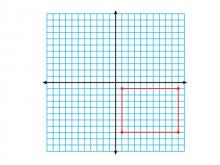
|
Math Clip Art--Geometry Concepts--Quadrilaterals--Rectangle in Q4 | Math Clip Art--Quadrilaterals--Rectangle in Q4TopicGeometry Concepts DescriptionThis image depicts a rectangle positioned in the fourth quadrant (Q4) of a coordinate grid. In Q4, the x-coordinates are positive while the y-coordinates are negative, completing the understanding of the Cartesian plane. Understanding how to place rectangles in different quadrants is fundamental in coordinate geometry. It helps students develop skills in graphing functions, analyzing data, and exploring geometric transformations. |
Definition of a Quadrilateral |

|
Math Clip Art--Geometry Concepts--Quadrilaterals--Square Centered at the Origin | Math Clip Art--Quadrilaterals--Square Centered at the OriginTopicGeometry Concepts DescriptionThis image shows a square centered at the origin of a coordinate grid. This positioning allows for easy analysis of its properties, such as symmetry and dimensions, using the Cartesian coordinate system. Understanding how to position geometric shapes at the origin is crucial for exploring concepts like symmetry, transformations, and coordinate geometry. This setup simplifies calculations involving distance, midpoint, and area. |
Applications of Coordinate Geometry and Definition of a Quadrilateral |
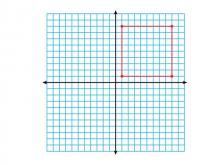
|
Math Clip Art--Geometry Concepts--Quadrilaterals--Square in Q1 | Math Clip Art--Quadrilaterals--Square in Q1TopicGeometry Concepts DescriptionThis image depicts a square positioned in the first quadrant (Q1) of a coordinate grid. In Q1, both the x and y coordinates are positive, making it a straightforward area for graphing and analysis. Placing a square in Q1 helps students understand the relationship between geometric shapes and their coordinate representations. It is useful for exploring concepts like area, perimeter, and transformations. |
Applications of Coordinate Geometry and Definition of a Quadrilateral |
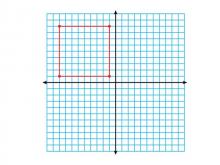
|
Math Clip Art--Geometry Concepts--Quadrilaterals--Square in Q2 | Math Clip Art--Quadrilaterals--Square in Q2TopicGeometry Concepts DescriptionThis image shows a square positioned in the second quadrant (Q2) of a coordinate grid. In Q2, the x-coordinates are negative while the y-coordinates are positive, which is important for understanding the full Cartesian plane. Understanding how to place squares in different quadrants helps students grasp the concept of negative and positive values in coordinate geometry. It is crucial for graphing functions, analyzing data, and understanding geometric transformations. |
Applications of Coordinate Geometry and Definition of a Quadrilateral |
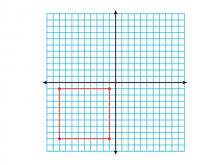
|
Math Clip Art--Geometry Concepts--Quadrilaterals--Square in Q3 | Math Clip Art--Quadrilaterals--Square in Q3TopicGeometry Concepts DescriptionThis image illustrates a square positioned in the third quadrant (Q3) of a coordinate grid. In Q3, both x and y coordinates are negative, which is essential for understanding the complete Cartesian coordinate system. Placing squares in different quadrants helps students understand the concept of negative values and their implications in geometry. It is crucial for graphing functions, analyzing data, and exploring geometric transformations. |
Applications of Coordinate Geometry and Definition of a Quadrilateral |
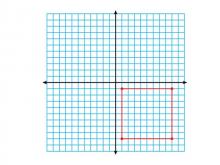
|
Math Clip Art--Geometry Concepts--Quadrilaterals--Square in Q4 | Math Clip Art--Quadrilaterals--Square in Q4TopicGeometry Concepts DescriptionThis image depicts a square positioned in the fourth quadrant (Q4) of a coordinate grid. In Q4, the x-coordinates are positive while the y-coordinates are negative, which is important for understanding the complete Cartesian plane. Placing a square in Q4 helps students understand the implications of positive and negative values in coordinate geometry. This understanding is essential for graphing functions, analyzing data, and exploring geometric transformations. |
Applications of Coordinate Geometry and Definition of a Quadrilateral |
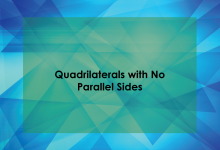
|
Math Clip Art--Geometry Basics--Quadrilaterals with No Parallel Sides 01 | Math Clip Art--Geometry Basics--Quadrilaterals with No Parallel Sides 01TopicGeometry Basics DescriptionThis image is part of a series on quadrilaterals with no parallel sides, serving as an introductory title card. It sets the stage for the upcoming mathematical concepts, capturing students' attention with its clear and concise presentation. The title card prominently displays "Quadrilaterals with Non-Parallel Sides," immediately informing viewers of the topic at hand. This visual cue helps students mentally prepare for the geometric concepts they're about to explore, creating a focused learning environment. |
Definition of a Quadrilateral |
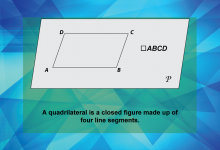
|
Math Clip Art--Geometry Basics--Quadrilaterals with No Parallel Sides 02 | Math Clip Art--Geometry Basics--Quadrilaterals with No Parallel Sides 02TopicGeometry Basics DescriptionThis image is the second in a series about quadrilaterals with no parallel sides. It presents a clear illustration of quadrilateral ABCD, accompanied by a caption explaining that a quadrilateral is a closed figure made up of four line segments. The visual representation of quadrilateral ABCD provides students with a concrete example of the concept. By showing a general quadrilateral without specifying parallel sides, it allows students to focus on the basic definition before delving into more specific types. |
Definition of a Quadrilateral |
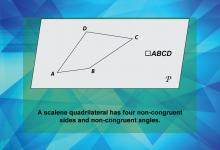
|
Math Clip Art--Geometry Basics--Quadrilaterals with No Parallel Sides 03 | Math Clip Art--Geometry Basics--Quadrilaterals with No Parallel Sides 03TopicGeometry Basics DescriptionThis image is the third in a series about quadrilaterals with no parallel sides. It features an illustration of quadrilateral ABCD, introducing the concept of a scalene quadrilateral. The caption explains that a scalene quadrilateral has four non-congruent sides and non-congruent angles. |
Definition of a Quadrilateral |
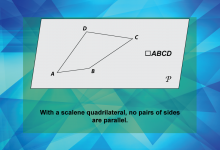
|
Math Clip Art--Geometry Basics--Quadrilaterals with No Parallel Sides 04 | Math Clip Art--Geometry Basics--Quadrilaterals with No Parallel Sides 04TopicGeometry Basics DescriptionThis image is the fourth in a series about quadrilaterals with no parallel sides. It presents an illustration of quadrilateral ABCD, emphasizing that in a scalene quadrilateral, no pairs of sides are parallel. The visual representation clearly shows a quadrilateral where none of the sides appear to be parallel, reinforcing the concept introduced in the caption. This helps students understand a key characteristic of scalene quadrilaterals and distinguishes them from other types of quadrilaterals that may have parallel sides. |
Definition of a Quadrilateral |
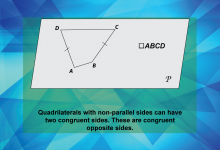
|
Math Clip Art--Geometry Basics--Quadrilaterals with No Parallel Sides 05 | Math Clip Art--Geometry Basics--Quadrilaterals with No Parallel Sides 05TopicGeometry Basics DescriptionThis image is the fifth in a series about quadrilaterals with no parallel sides. It illustrates quadrilateral ABCD, introducing the concept that quadrilaterals with non-parallel sides can have two congruent sides, specifically congruent opposite sides. The visual representation clearly shows a quadrilateral where two opposite sides are marked as congruent, while maintaining the non-parallel nature of the sides. This helps students understand that even without parallel sides, quadrilaterals can still have some elements of symmetry or congruence. |
Definition of a Quadrilateral |

|
Math Clip Art--Geometry Basics--Quadrilaterals with No Parallel Sides 06 | Math Clip Art--Geometry Basics--Quadrilaterals with No Parallel Sides 06TopicGeometry Basics DescriptionThis image is the sixth in a series about quadrilaterals with no parallel sides. It presents an illustration of quadrilateral ABCD, demonstrating that quadrilaterals with non-parallel sides can have two congruent sides, specifically congruent adjacent sides. |
Definition of a Quadrilateral |

|
Math Clip Art--Geometry Basics--Quadrilaterals with No Parallel Sides 07 | Math Clip Art--Geometry Basics--Quadrilaterals with No Parallel Sides 07TopicGeometry Basics DescriptionThis image is the seventh in a series about quadrilaterals with no parallel sides. It features an illustration of kite ABCD, introducing the concept that a kite is a quadrilateral with two pairs of congruent adjacent sides. The visual representation clearly shows a kite-shaped quadrilateral where two pairs of adjacent sides are marked as congruent. This helps students understand the unique characteristics of a kite and how it differs from other quadrilaterals they've encountered in this series. |
Definition of a Quadrilateral |

|
Math Clip Art--Geometry Basics--Quadrilaterals with No Parallel Sides 08 | Math Clip Art--Geometry Basics--Quadrilaterals with No Parallel Sides 08TopicGeometry Basics DescriptionThis image is the eighth in a series about quadrilaterals with no parallel sides. It features an illustration of kite ABCD, introducing the concept that a kite is essentially composed of two isosceles triangles sharing a common side. The visual representation clearly shows how the kite can be divided into two isosceles triangles, helping students understand the underlying structure of this unique quadrilateral. This perspective offers a new way of thinking about kites, connecting them to previously learned concepts about isosceles triangles. |
Definition of a Quadrilateral |
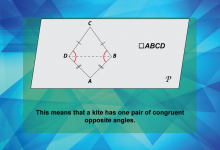
|
Math Clip Art--Geometry Basics--Quadrilaterals with No Parallel Sides 09 | Math Clip Art--Geometry Basics--Quadrilaterals with No Parallel Sides 09TopicGeometry Basics DescriptionThis image is the ninth in a series about quadrilaterals with no parallel sides. It illustrates kite ABCD, highlighting that a kite has one pair of congruent opposite angles. The visual representation clearly shows the pair of congruent opposite angles in the kite, building on the previous concept of a kite being composed of two isosceles triangles. This helps students understand how the structure of a kite leads to specific geometric properties, such as angle congruence. |
Definition of a Quadrilateral |
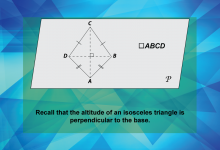
|
Math Clip Art--Geometry Basics--Quadrilaterals with No Parallel Sides 10 | Math Clip Art--Geometry Basics--Quadrilaterals with No Parallel Sides 10TopicGeometry Basics DescriptionThis image is the tenth in a series about quadrilaterals with no parallel sides. It illustrates kite ABCD, recalling that the altitude of an isosceles triangle is perpendicular to its base. The visual representation shows the altitude of one of the isosceles triangles that make up the kite, emphasizing its perpendicular relationship to the base. This helps students connect their knowledge of isosceles triangles to the properties of kites, building a more comprehensive understanding of geometric relationships. |
Definition of a Quadrilateral |
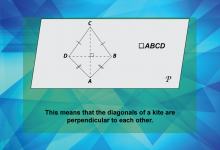
|
Math Clip Art--Geometry Basics--Quadrilaterals with No Parallel Sides 11 | Math Clip Art--Geometry Basics--Quadrilaterals with No Parallel Sides 11TopicGeometry Basics DescriptionThis image is the eleventh in a series about quadrilaterals with no parallel sides. It illustrates kite ABCD, demonstrating that the diagonals of a kite are perpendicular to each other. The visual representation clearly shows the perpendicular diagonals of the kite, building on the previous concept of the altitude in an isosceles triangle. This helps students understand how the unique structure of a kite leads to this important property, connecting previously learned concepts to new geometric insights. |
Definition of a Quadrilateral |
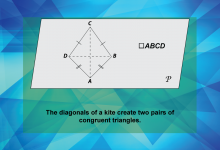
|
Math Clip Art--Geometry Basics--Quadrilaterals with No Parallel Sides 12 | Math Clip Art--Geometry Basics--Quadrilaterals with No Parallel Sides 12TopicGeometry Basics DescriptionThis image is the twelfth in a series about quadrilaterals with no parallel sides. It illustrates kite ABCD, showing that the diagonals of a kite create two pairs of congruent triangles. The visual representation clearly highlights the congruent triangles formed by the diagonals of the kite. This helps students understand another important property of kites, building on their knowledge of congruent triangles and connecting it to the unique structure of kites. |
Definition of a Quadrilateral |
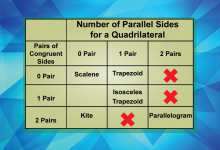
|
Math Clip Art--Geometry Basics--Quadrilaterals with No Parallel Sides 13 | Math Clip Art--Geometry Basics--Quadrilaterals with No Parallel Sides 13TopicGeometry Basics DescriptionThis image is the thirteenth and final in a series about quadrilaterals with no parallel sides. It presents a comprehensive table summarizing quadrilaterals with zero, one, and two pairs of parallel sides, as well as pairs of congruent sides. |
Definition of a Quadrilateral |

|
Math Clip Art--Geometry Basics--Quadrilaterals with Parallel Sides 01 | Math Clip Art--Geometry Basics--Quadrilaterals with Parallel Sides 01TopicGeometry Basics DescriptionThis math clip art image serves as the introductory title card for a series focusing on quadrilaterals with parallel sides. It prominently displays the topic's title, setting the stage for the geometric concepts to be explored in subsequent images. The clear and bold presentation of the subject matter immediately captures students' attention and provides a visual anchor for the lesson. |
Definition of a Quadrilateral |

|
Math Clip Art--Geometry Basics--Quadrilaterals with Parallel Sides 02 | Math Clip Art--Geometry Basics--Quadrilaterals with Parallel Sides 02TopicGeometry Basics DescriptionThis math clip art image introduces the fundamental concept of a quadrilateral. It presents an illustration of quadrilateral ABCD, emphasizing its defining characteristic as a closed figure composed of four line segments. The image clearly labels the vertices of the quadrilateral as A, B, C, and D, providing a visual representation of the basic definition of a quadrilateral and its components. |
Definition of a Quadrilateral |
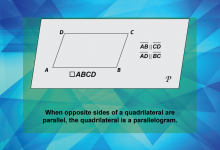
|
Math Clip Art--Geometry Basics--Quadrilaterals with Parallel Sides 03 | Math Clip Art--Geometry Basics--Quadrilaterals with Parallel Sides 03TopicGeometry Basics DescriptionThis math clip art image introduces the concept of a parallelogram, a specific type of quadrilateral. It presents an illustration of quadrilateral ABCD, highlighting its defining feature: opposite sides that are parallel to each other. The image visually demonstrates how this characteristic transforms a general quadrilateral into a parallelogram, helping students understand the key distinction between these geometric shapes. |
Definition of a Quadrilateral |
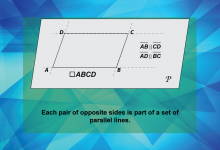
|
Math Clip Art--Geometry Basics--Quadrilaterals with Parallel Sides 04 | Math Clip Art--Geometry Basics--Quadrilaterals with Parallel Sides 04TopicGeometry Basics DescriptionThis math clip art image delves deeper into the concept of parallelograms by illustrating how each pair of opposite sides in quadrilateral ABCD is part of a larger set of parallel lines. The image visually extends the sides of the parallelogram, demonstrating that these lines remain parallel indefinitely. This representation helps students grasp the fundamental property of parallelograms and understand how it relates to the broader concept of parallel lines in geometry. |
Definition of a Quadrilateral |
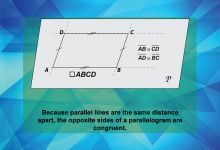
|
Math Clip Art--Geometry Basics--Quadrilaterals with Parallel Sides 05 | Math Clip Art--Geometry Basics--Quadrilaterals with Parallel Sides 05TopicGeometry Basics DescriptionThis math clip art image illustrates an important property of parallelograms: the congruence of opposite sides. It shows quadrilateral ABCD, emphasizing that the parallel nature of opposite sides results in these sides being the same length. This property is a direct consequence of the fact that parallel lines maintain a constant distance from each other. The image visually demonstrates this concept, helping students understand why opposite sides in a parallelogram are always congruent. |
Definition of a Quadrilateral |
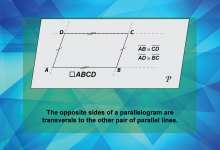
|
Math Clip Art--Geometry Basics--Quadrilaterals with Parallel Sides 06 | Math Clip Art--Geometry Basics--Quadrilaterals with Parallel Sides 06TopicGeometry Basics DescriptionThis math clip art image introduces the concept of transversals in the context of parallelograms. It illustrates how the opposite sides of parallelogram ABCD function as transversals to the other pair of parallel lines. The image clearly shows how each pair of opposite sides intersects the other pair of parallel lines, demonstrating the role of transversals in parallelograms. This representation helps students understand the relationship between parallel lines and transversals within the structure of a parallelogram. |
Definition of a Quadrilateral |
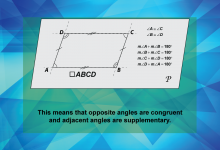
|
Math Clip Art--Geometry Basics--Quadrilaterals with Parallel Sides 07 | Math Clip Art--Geometry Basics--Quadrilaterals with Parallel Sides 07TopicGeometry Basics DescriptionThis math clip art image explores the angle relationships in parallelograms. It illustrates quadrilateral ABCD, highlighting two key properties: the congruence of opposite angles and the supplementary nature of adjacent angles. These properties are direct consequences of the parallel sides and transversal relationships in parallelograms. The image visually demonstrates these angle relationships, helping students grasp these important characteristics of parallelograms. |
Definition of a Quadrilateral |
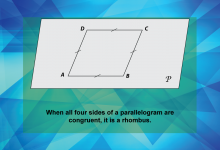
|
Math Clip Art--Geometry Basics--Quadrilaterals with Parallel Sides 08 | Math Clip Art--Geometry Basics--Quadrilaterals with Parallel Sides 08TopicGeometry Basics DescriptionThis math clip art image introduces the concept of a rhombus, a special type of parallelogram. It presents an illustration of quadrilateral ABCD, emphasizing its defining characteristic: all four sides are congruent. This property distinguishes a rhombus from other parallelograms, showcasing how specific conditions can create unique quadrilaterals within the broader category of shapes with parallel sides. |
Definition of a Quadrilateral |

|
Math Clip Art--Geometry Basics--Quadrilaterals with Parallel Sides 09 | Math Clip Art--Geometry Basics--Quadrilaterals with Parallel Sides 09TopicGeometry Basics DescriptionThis math clip art image introduces the concept of a rectangle, another special type of parallelogram. It presents an illustration of quadrilateral ABCD, highlighting its defining characteristic: all four angles are right angles. This property distinguishes a rectangle from other parallelograms, demonstrating how specific angle conditions can create unique quadrilaterals within the broader category of shapes with parallel sides. |
Definition of a Quadrilateral |
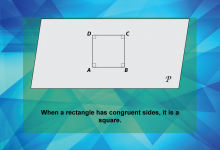
|
Math Clip Art--Geometry Basics--Quadrilaterals with Parallel Sides 10 | Math Clip Art--Geometry Basics--Quadrilaterals with Parallel Sides 10TopicGeometry Basics DescriptionThis math clip art image introduces the concept of a square, a special type of rectangle and rhombus. It presents an illustration of quadrilateral ABCD, emphasizing its unique properties: all four sides are congruent and all four angles are right angles. This combination of characteristics makes the square a distinct shape that embodies the properties of both rectangles and rhombuses. |
Definition of a Quadrilateral |